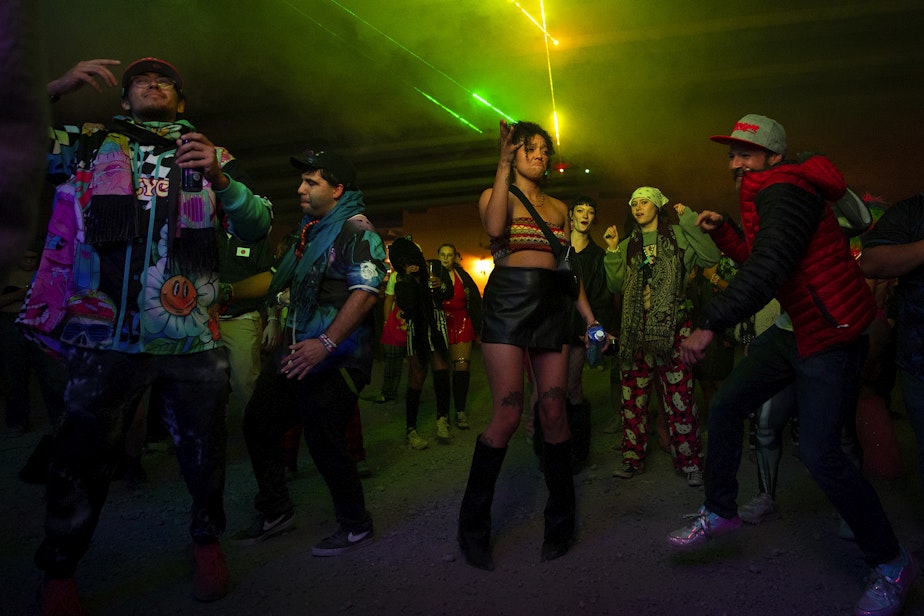Seattle's underground rave scene is raging, from underpasses to rooftops

These days you can pay big bucks to go to a rave in Seattle, usually at a nightclub or even a stadium. But many ravers in town are looking for secret, underground shows. We went out to find these supposed "renegades."
S
omewhere hidden deep in the snarl of train tracks and warehouses of Seattle’s SoDo neighborhood, there's live music that makes the ground shake.
Tucked beneath a bridge just north of the Duwamish is the dusty, gravel lot music lovers whisper about online.
This is a renegade: a DJ blasting music, a fog machine, and many dancing bodies.
Michael, a 25-year-old software engineer, was here a few weeks ago and noticed something was missing: No light show. No lasers.
“A rave without lasers is like an angel without wings,” Michael recalls saying to himself.
So, he talked to the show promoter, they bought some gear, and now Michael sits next to the DJs at the gravel lot and runs the laser show all night. That's the spirit of these unofficial raves: A guy who has no experience can jump in and be part of the show.
Michael doesn't want to share his last name because, well, these raves aren't exactly permitted. The DJs, the lights, the fog machine: it's all set up on a whim. And it's not just under this bridge.
“It’s everywhere,” says Josh Repple, one of the many DJs who makes these shows happen. “We go on rooftops, we do beaches, we do parks."
Renegades are free, often announced a day or two before they happen, and usually only promoted on Instagram and TikTok. Most shows start around 10 o’clock and are scheduled to go until one in the morning — though most ravers stay for after-parties (called “afters”) that keep raging until 4 or 5 a.m.
"This is new, dude, the way it's happening,” Repple says, gesturing to the dancing crowd, shrouded in fog. “How instant, like, we didn't plan this or nothing. We're just like, ‘Oh, we're finna pop up.’”
That's the freedom of these shows: no cover charge and no security.

But that's not entirely brand new, says longtime Seattle radio DJ, Drew Bailey.
Bailey is a self-described proud, lifelong raver who hosts the morning show on C89.5, the longest running dance station in the country.
Bailey recalled one of his favorite shows, a renegade in a liquor store on First Avenue South in 2009.
"It was Christmas night, and someone broke in and we threw a big party, and it was the most amazing time,” Bailey said. “So, it doesn't matter where it is as long as you have the music, something to amplify it, and then people to dance. Doesn't matter where it is."
Back then, breaking into liquor stores on Christmas was one of the few places you could enjoy that kind of music. One of the few established clubs for ravers was NAF Studios in West Seattle, an industrial venue that closed in 2002.
“That was like the place to be,” Bailey said. “We complain about it, how dirty and sticky and gross it was, but now, 20 plus years later, we still can't stop talking about it.”
Raves and electronica music belonged to a small subset of fans. The word "rave" was synonymous with drugs — even though people did drugs at all kinds of shows.
Bailey says some DJs even stopped using the word rave altogether and called them parties because of the stigma.
"We weren't the cool kids, right? They made fun of us,” he said. “You know, every joke was about a glow stick."
Over time, as more people have gone to a show, that reputation has changed. Now, electronic music has gone mainstream. DJs sell out huge venues like the Gorge. There are now multiple clubs in town like Trinity and Monkey Loft for people to enjoy all kinds of different genres of electronica.
One of the reasons for this growth is that the music has become more inclusive. Bailey attributes the positive vibes to an old maxim: PLURR.
"Peace love, unity, and respect, the old raver mantra, which was key to the early Seattle rave scene,” he explained. “I like to add an extra R, so: peace, love, unity, respect, and responsibility. Because you got to be careful out there."

B
ack at the renegade beneath the bridge in SoDO, crowds of dancers spin around in the gravel, cheering when trains pass.
It’s almost 2:30 in the morning and Aex Zacapu, known onstage as R3TRÖ, is about to perform his set.
The crowd is still going strong, ready for more music, and Zacapu says there’s no other place he’d want to be DJing.
"Putting on free shows is all I care about,” he said. “I don't make any money off of it. But it doesn't matter. You know, I love putting smiles on people's faces. love the energy that I put out and other people bring out. So, it means a lot."
More shows are planned every weekend this fall beneath the bridge. It's easier to find now: you can't miss the new lasers.




